Balinese Food and Specialties
In Indonesia, and particularly in Bali, we eat well. Rice is the staple, of course, and the national dish goes by the name of nasi goreng: fried rice with eggs, small pieces of meat and vegetables, or shrimp. Roasted suckling pig, smoked duck with spices, crisp salad: the Balinese cultural richness is also expressed in its cuisine. Here is an overview of tastiest Balinese food.
But Indonesian food is a reflection of the ethnic mosaic that the country represents: rich, surprising, varied and colorful.
Wheat is the second most consumed cereal.
All of these culinary specialties of Bali reflect the rich culinary culture of Indonesia and are worth trying if you visit the island. Bali is known for its mouth-watering food that offers a perfect blend of spices, herbs, and fresh ingredients.
Please note: sodium glutamate is often used to bring out the flavors better. However, this product is not recommended for people with heart problems or suffering from hypertension. Fish brine also has the same effect.
Finally, Chinese cuisine is also well represented, and in tourist places you will generally find, in addition, a whole range of Western-inspired dishes, from steak to pizzas and spaghetti, and sometimes even Mexican specialties such as tacos or guacamole!
Just like in many Asian countries, street food is ubiquitous. For small budgets, street vendors in kaki lima (a kind of small trailers) offer lots of dishes at low prices!
Good to know: If you have to remember a word from Bahasa Indonesia: remember the word goreng, it means fried. He will guide you on the preparation of the dishes and give you an idea of what to expect when your order arrives. Indeed, from appetizers to desserts, many foods are goreng in Indonesian cuisine.
Best Balinese Restaurants in Bali | Discover Bali’s Culinary Gems
Balinese specialties | Drink and eat Local
Balinese food is varied, colorful and spicy. Clearly, it gives even more flavor to your trips to Bali. We would go back just for that!
There is a wide variety of dishes based on fish (Ikan), chicken (Ayam), beef (Daging) and other meats, often accompanied by the traditional rice. Vegetarians are not left out with the tempe, a specialty made from soybeans, or tofu… There is plenty to enjoy, as with this special vegetarian starter.
And besides, you won’t have to spend a lot to delight your palate. In Bali, you eat for the equivalent of a few Euros, AUD, USD… (in Rupiahs).
Nasi Goreng
Nasi goreng is a popular Indonesian dish that is also very popular in Bali. It is a fried rice dish with vegetables, spices, meat, eggs, and sometimes seafood. Nasi goreng is often served with shrimp crackers and sweet chili sauce. Read also: Breakfast at Villa Carissa Bali | Menu and Floating Breakfast
Nasi Goreng or Mie Goreng: Typical dish from Indonesia. Made with rice (Nasi) or noodles (Mie) and spices. Often served with chicken or eggs.
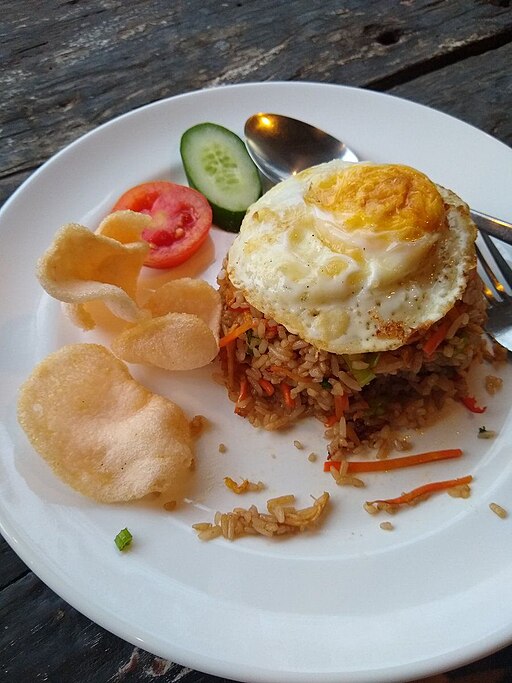
Nasi goreng, fried rice. Siliconprophet, CC BY-SA 4.0, via Wikimedia Commons
What’s so special about Balinese nasi goreng apart to other nasi goreng?
Balinese Nasi Goreng, like other types of Nasi Goreng, is a traditional Indonesian fried rice dish that is popular throughout the country and beyond. However, there are several features that make Balinese Nasi Goreng special and distinct from other variations of the dish:
- Spicier: Balinese Nasi Goreng is typically spicier than other types of Nasi Goreng. This is because it uses more chili peppers and other spices in the cooking process, which gives the dish a fiery kick.
- Shrimp Paste: Balinese Nasi Goreng often contains shrimp paste, which is a traditional ingredient in Balinese cuisine. This gives the dish a unique and savory flavor that is distinct from other types of Nasi Goreng.
- Traditional Herbs: Balinese Nasi Goreng is often made with traditional Balinese herbs and spices, such as lemongrass, galangal, and turmeric. This gives the dish a rich and complex flavor profile that is unique to Balinese cuisine.
- Toppings: Balinese Nasi Goreng is often served with a variety of toppings, such as sliced cucumber, tomato, and fried shallots, which add a refreshing crunch and depth of flavor to the dish.
Read here to get the recipe.
Nasi Goreng with chicken and satay. Lord Mountbatten, CC BY-SA 4.0, via Wikimedia Commons
Overall, Balinese Nasi Goreng is a special and distinct variation of the traditional Indonesian fried rice dish that is beloved in Bali and beyond. Its spiciness, use of shrimp paste and traditional herbs, and variety of toppings make it a flavorful and satisfying meal that is perfect for any occasion.
Urab
Delicious mixture of coconut, beans or other finely chopped vegetables flavored with spices and peppers. Mainly Balinese dish.
Urab is a traditional Balinese dish that consists of mixed vegetables, grated coconut, and sometimes minced meat or shrimp. The vegetables used in urab can vary, but commonly include bean sprouts, green beans, cabbage, and spinach.
The vegetables are blanched (quickly cooking food in boiling water then dunking it in ice water to stop the cooking process), chopped finely, and then mixed with spices such as shallots, garlic, chili, shrimp paste, and lime juice. The mixture is then topped with grated coconut and sometimes fried shallots.
Urab is often served as a side dish or accompaniment to other Balinese dishes, such as satay or grilled fish. It is a healthy and flavorful dish that is popular among both locals and tourists in Bali.
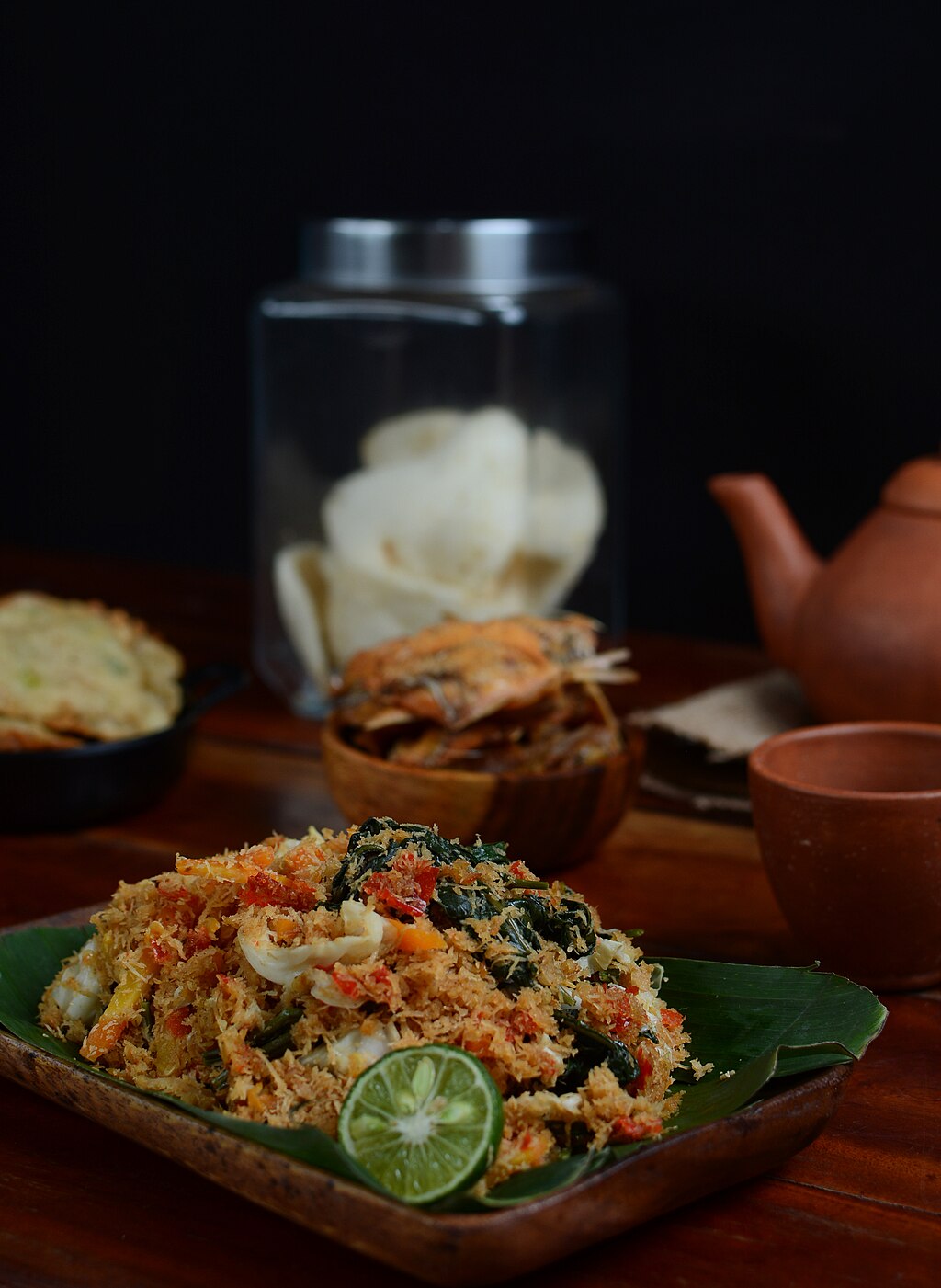
Urab is a typical Indonesian dish made from various kinds of vegetables mixed with grated coconut. Irhanz, CC BY-SA 4.0, via Wikimedia Commons
Babi guling, roasted suckling pig
Stuffed pig roasted on a spit. Excellent when it is not too greasy. It is mainly found in Bali, the rest of the archipelago being overwhelmingly Muslim.
Babi guling is a traditional dish of grilled pork stuffed with herbs and spices, often served with white rice and stir-fried vegetables. It is a very popular dish in Bali, often served at special occasions such as weddings and religious ceremonies.
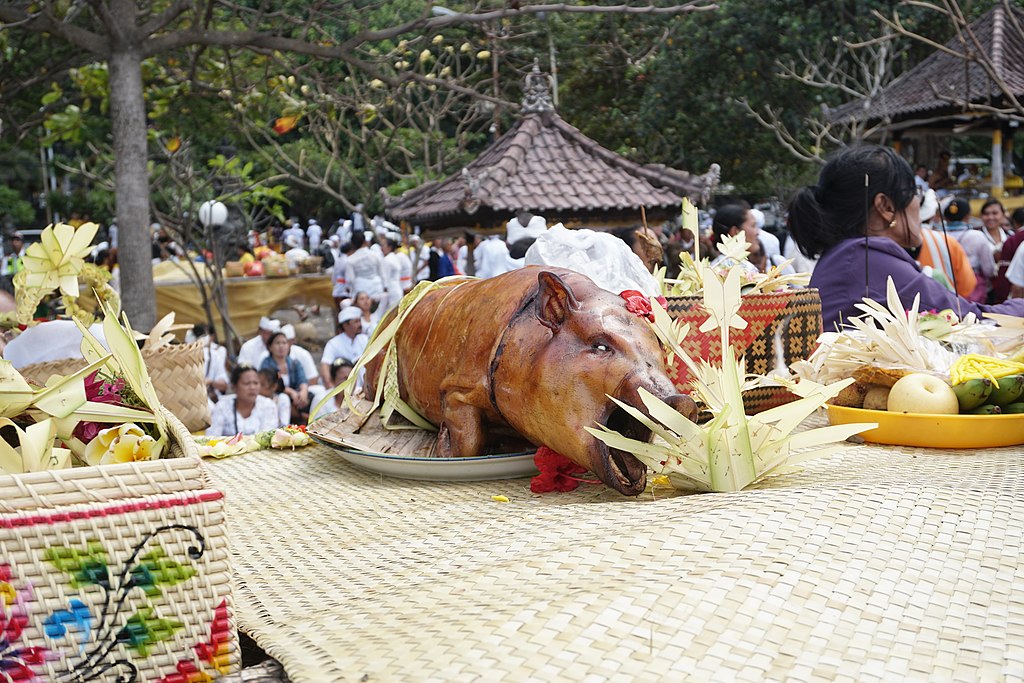
Babi Guling is one of the offerings in religious ceremonies in Bali. I Kadek Jaya Wiguna, CC BY-SA 4.0, via Wikimedia Commons
Balinese pork soto
Balinese Pork Soto, also known as Soto Babi, is a traditional Indonesian soup made with pork meat and broth, along with a variety of herbs and spices. The soup is typically served with rice and topped with fried shallots, boiled eggs, and sliced tomatoes. It is a popular dish in Bali and other parts of Indonesia.
The soup is made by boiling pork bones and meat in a pot with water and aromatics such as garlic, shallots, ginger, and lemongrass. The broth is then flavored with a mix of ground spices, such as coriander, cumin, turmeric, and pepper. Other ingredients such as vermicelli noodles, bean sprouts, and fresh herbs like cilantro and scallions are also added to the soup.
Balinese pork soto, a traditional soup. Gunawan Kartapranata, CC BY-SA 4.0, via Wikimedia Commons
Overall, Balinese Soto Babi Bali is a delicious and nutritious dish that is beloved in Bali and throughout Indonesia. Its rich and flavorful broth, tender pork meat, and variety of toppings make it a satisfying and comforting meal that is perfect for cooler weather or anytime you’re in the mood for a hearty soup. Sometimes this soup is served as a side dish with the babi guling (roasted suckling pig).
Lawar, mixed vegetables
Lawar is a salad dish of minced meat and vegetables, mixed with spices and coconut milk. There are many variations of lawar, but most contain pork or chicken, along with vegetables such as green beans, eggplant, and papaya leaves.
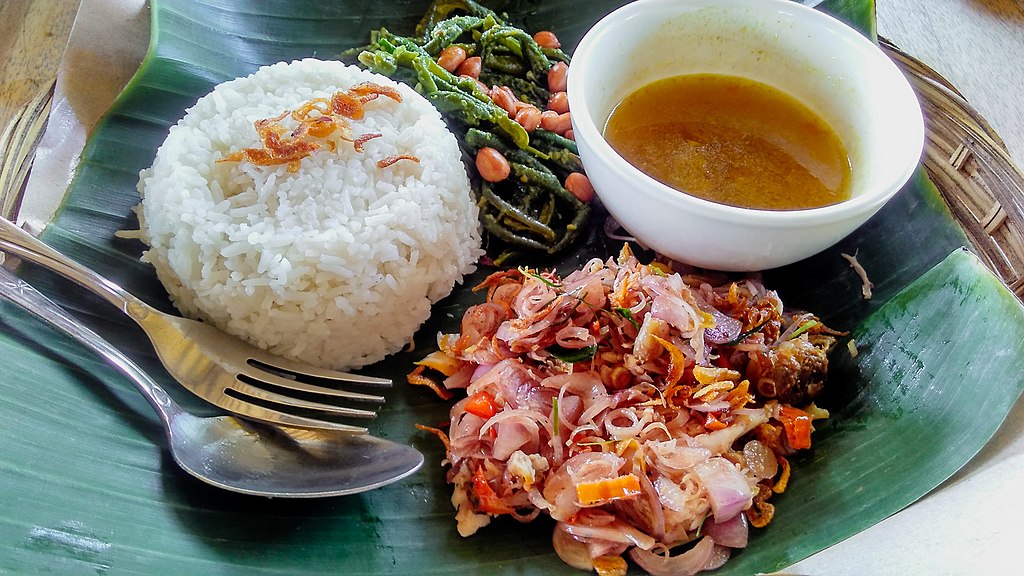
Balinese chicken lawar with rice. RT. Hakimi, CC BY-SA 4.0, via Wikimedia Commons
Sate lilit
Sate lilit is a variation of satay where the meat is mixed with spices, grated coconut and other ingredients before being wrapped around a lemongrass or bamboo stalk and grilled. It is a very popular dish in Bali and is often served with a spicy sambal sauce.
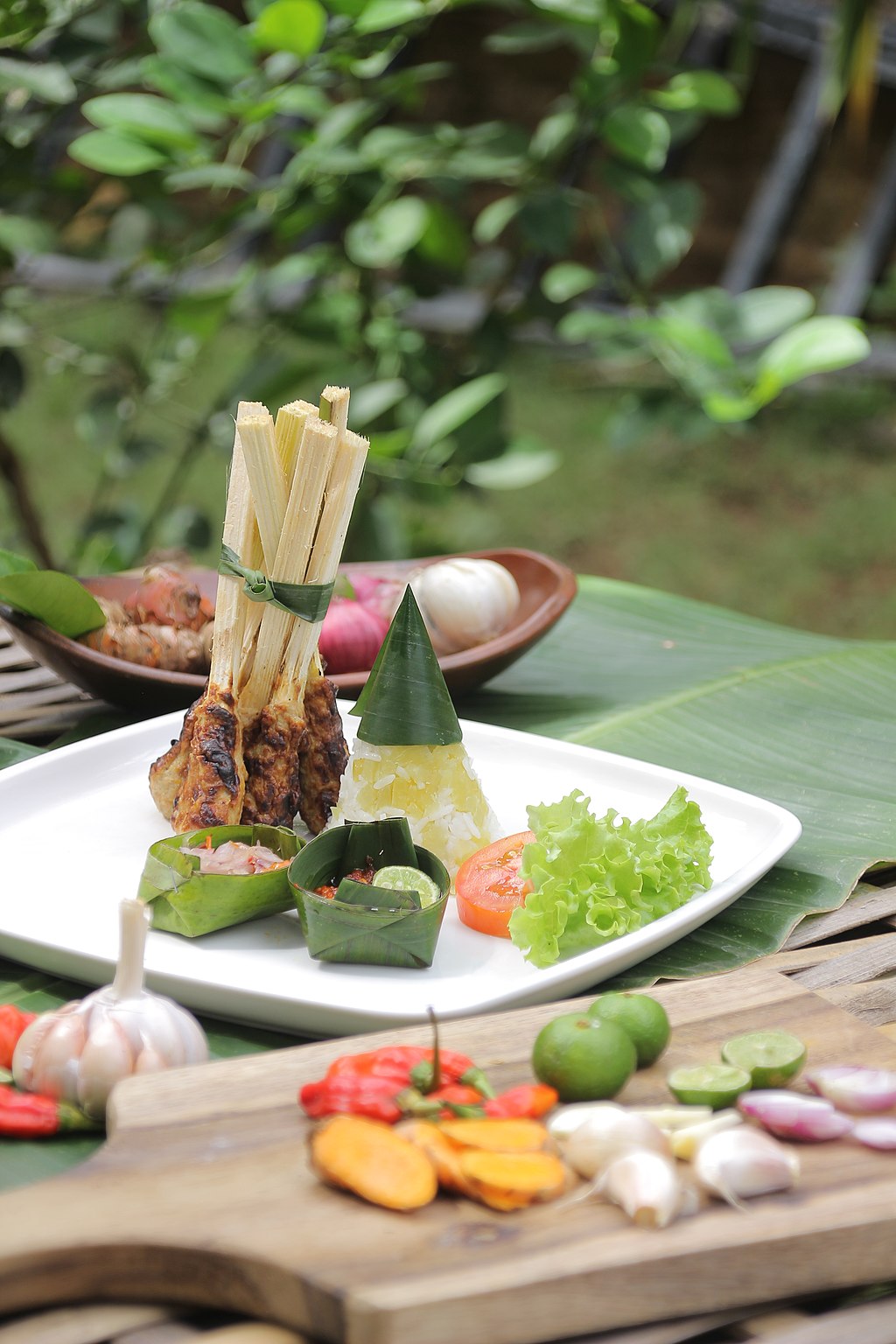
Bali’s famous satay style, served with rice. The term ‘lilit’ in Balinese and in Indonesian means “to wrap”. The wider surface allows the minced meat to adhere. Kresnanta, CC BY-SA 4.0, via Wikimedia Commons
Satay lilit is a Balinese culinary specialty that consists of meatballs of chicken, beef, pork, fish or shrimp, mixed with grated coconut, spices and herbs, and wrapped around a stalk of lemongrass or bamboo.
Read here to get the recipe.
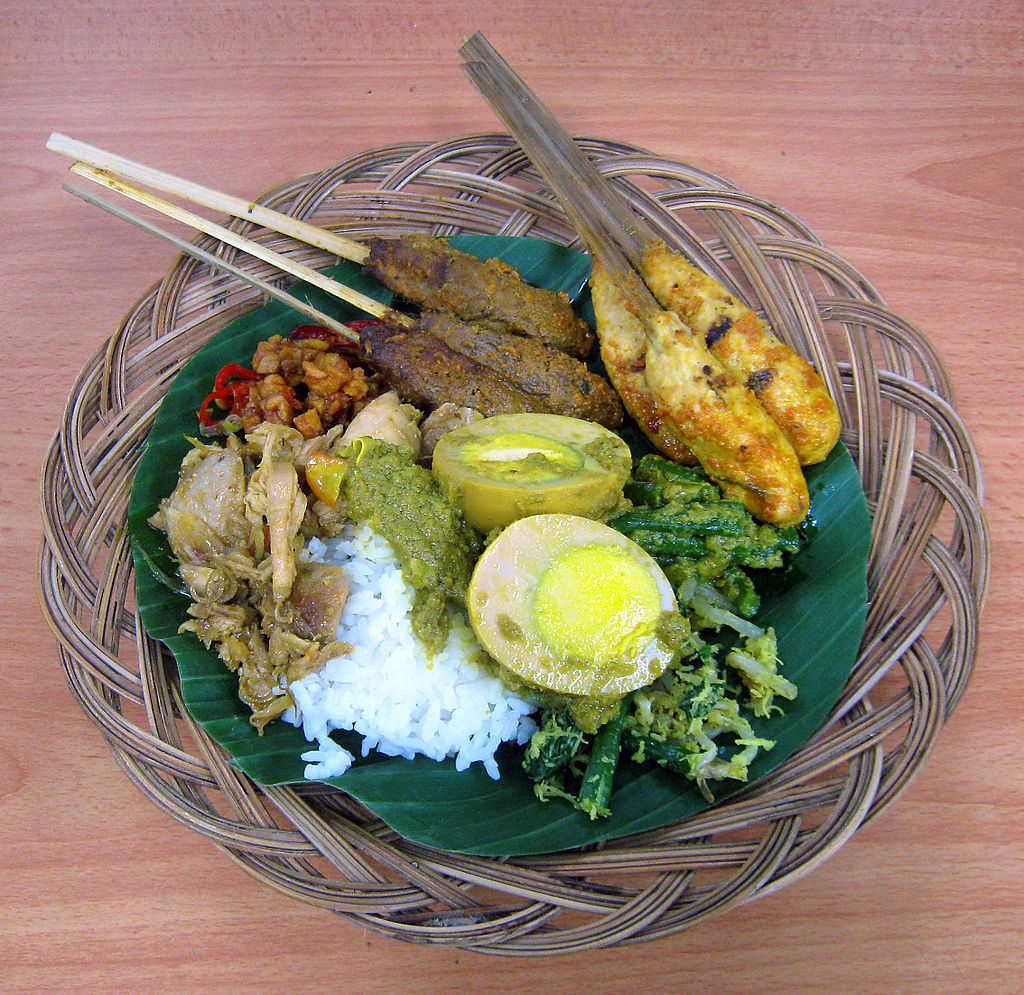
Balinese Nasi Campur (mixed rice) with two types of Sate Lilit (meat and fish), egg, chicken and vegetables. Gunawan Kartapranata, CC BY-SA 3.0, via Wikimedia Commons
Balinese pork satay
The pork is cut into small pieces, marinated and then threaded onto sticks of coconut wood or bamboo then cooked over charcoal embers.
Read here to get the recipe.

Balinese Sate Babi (pork satay). Gunawan Kartapranata, CC BY-SA 4.0, via Wikimedia Commons
Sate
The difference between Balinese and normal satay!
The main difference between Balinese Satay and “normal” Satay is the use of different ingredients and flavors. Balinese Satay uses local and traditional ingredients from Bali to create a unique and distinct flavor and and wrapped around a stalk of lemongrass or bamboo.
Balinese Satay is usually marinated in a sauce made from coconut milk, peanut paste, palm sugar, garlic, and spices like turmeric, cumin, and coriander. The meat is then grilled on skewers and served with peanut satay sauce.
“Normal” Satay, on the other hand, can be marinated in a variety of different sauces depending on the region of Southeast Asia. For example, Indonesian Satay often uses a marinade made from soy sauce, tamarind, sugar and spices. Thai Satay often uses a marinade made from coconut milk, curry, peanut paste and lemongrass.
In summary, the main difference between Balinese Satay and “normal” Satay is the ingredients and flavors used in the marinade and the Satay sauce. Balinese Satay uses local and traditional ingredients from Bali to create a unique and delicious flavor.
Read here to get the recipe.
Tipat cantok, mixed salad with rice cake
Balinese Tipat Cantok is a traditional Balinese dish that consists of a mixed salad with rice cake. The dish typically includes boiled rice cake cubes, bean sprouts, green beans, grated coconut, and sliced cucumber, which are all mixed together in a spicy peanut sauce.
To make the peanut sauce, peanuts are roasted and then ground into a paste, and mixed with other ingredients such as chili peppers, garlic, shallots, and palm sugar. The mixture is then thinned out with coconut milk and tamarind juice to create a thick and flavorful sauce.
Once the peanut sauce is ready, the salad ingredients are mixed together and topped with the sauce. The dish is often served with shrimp crackers or krupuk, which add a crunchy texture to the dish.
Balinese Tipat Cantok is a popular dish in Bali and can be found in many local restaurants and food stalls (but not many tourist know about this dish). It is a delicious and satisfying dish that combines the freshness of the salad with the richness and spiciness of the peanut sauce.
Read here to get the recipe.
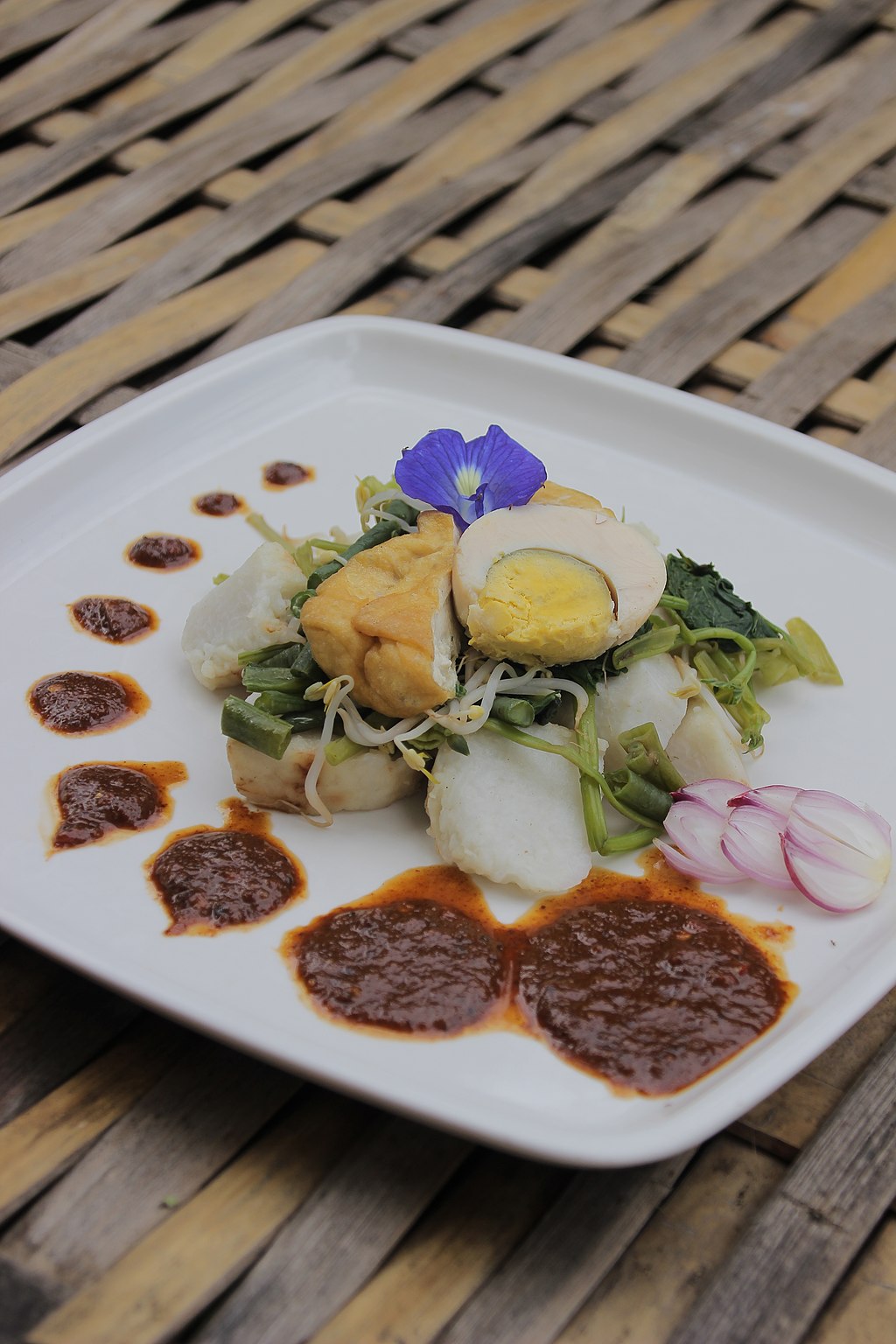
Gourmet version of Tipat Cantok. Bali’s mixed vegetables with “tipat” rice, tofu, and egg, served with peanut sauce. Kresnanta, CC BY-SA 4.0, via Wikimedia Commons
Bebek Betutu, Balinese duck speciality
A tasty Balinese duck speciality. Stuffed and stewed for a long time in a banana leaf, normally it is always ordered the day before.
Bebek betutu is a dish of duck stuffed with herbs and spices, wrapped in banana leaves and steamed or cooked over a wood fire for several hours. It is a traditional festive dish in Bali and is often served at weddings and religious ceremonies.
Read here to get the recipe.

Hanged Ayam Betutu and Bebek Betutu. Gunawan Kartapranata, CC BY-SA 4.0, via Wikimedia Commons
Ayam Betutu, grilled stuffed chicken, served with vegetables, tapioca and coconut
Ayam Betutu is a traditional Balinese dish of chicken stuffed with spices and herbs, wrapped in banana leaves and slowly cooked in steam or over a wood fire.
The chicken is marinated in a mixture of spices and herbs for several hours, then stuffed with cooked rice, shredded coconut, shallots, garlic and other ingredients before being cooked.
Read here to get the recipe.

Ayam Betutu. Gunawan Kartapranata, CC BY-SA 3.0, via Wikimedia Commons
Kacang disco, spicy roasted peanuts
Kacang Disco is a popular Indonesian snack that is made from roasted peanuts and crispy fried flour. The snack is named “disco” due to the small ball-shaped flour that resembles small disco balls. Kacang means peanuts in Indonesian, so the snack is essentially a peanut-based snack.
It is commonly sold as a street food snack in Indonesia and is often served as an appetizer or a snack during social gatherings. Kacang Disco is enjoyed for its crispy texture and nutty flavor, and it is often served with a side of chili sauce or as a topping for other dishes.
Kacang disco Bali. Hot and spicy peanuts, product of Bali, Indonesia. Midori, CC BY-SA 3.0, via Wikimedia Commons
Pisang Goreng, fried banana
Pisang goreng is a popular dessert in Bali, which consists of bananas coated in batter and fried until golden brown and crispy. The fried bananas are then sprinkled with sugar and served hot.
Read here to get the recipe.

Pisang goreng, fried banana. Kyrosyahmi, CC BY-SA 4.0, via Wikimedia Commons
Bubur Injin, sweet black rice porridge
Bubur Injin is a sweet black rice porridge that is a popular dessert in Bali, Indonesia. It is made from black glutinous rice that has been soaked overnight and then cooked with water, coconut milk, and palm sugar to create a sweet and creamy porridge.
It is often served hot, with a variety of toppings such as sliced bananas, shredded coconut, or roasted peanuts. Bubur Injin is a traditional Balinese dish that is enjoyed as a breakfast or dessert.

Bubur injin is Balinese version of bubur ketan hitam, or sweet black rice porridge served with coconut milk. Gunawan Kartapranata, CC BY-SA 4.0, via Wikimedia Commons
Balinese drinks
– In tourist areas, and more particularly in Bali, restaurants offer Australian wines (good but expensive), but also Balinese wine (grape this one) which is drunk very well in these latitudes. They are also served in carafes or by the glass. The rosé is a little sweet, but it “stings” quickly. The white is drier, therefore better.
– Fresh fruit juices are all the rage, especially in Bali. Passed through the blender, they keep all their flavor. Taste the avocado (apokat), which somewhat resembles the flavor of candied chestnuts because it is mixed with chocolate powder! Delicious. Fruit juices are generally served with crushed ice (ask for them preceded by the word es), the heat obliges!
In principle, ice is made with boiled or sterilized water, especially in tourist places. You will be surprised in the markets by all the colorful drinks that Indonesians are fond of. Some have beautiful colors… fluorescent. Es campur, found on many restaurant menus, is a mixture of fruit, jelly and crushed ice. There are lots of variations.
Of course, there are also all the chemical drinks: Coca-Cola, lemonades, etc.

Brem a Balinese rice wine. Hegariz at English Wikipedia, CC BY-SA 3.0, via Wikimedia Commons
Photo credit (main picture): Withlocals B.V., CC BY-SA 4.0, via Wikimedia Commons
Discover the Exotic Flavors of Bali: Authentic Balinese Recipes to Try at Home
Have you booked your villa in Seminyak center, Bali?
Located in Seminyak Center – Bali, Villa Carissa offers a private swimming pool and enclosed garden to guarantee your privacy. You can book your private pool villa here with us.
Whether you’re traveling with family, friends, or on a romantic getaway, villa Carissa in Seminyak center offers the perfect base for exploring Bali’s many attractions and enjoying a relaxing vacation.


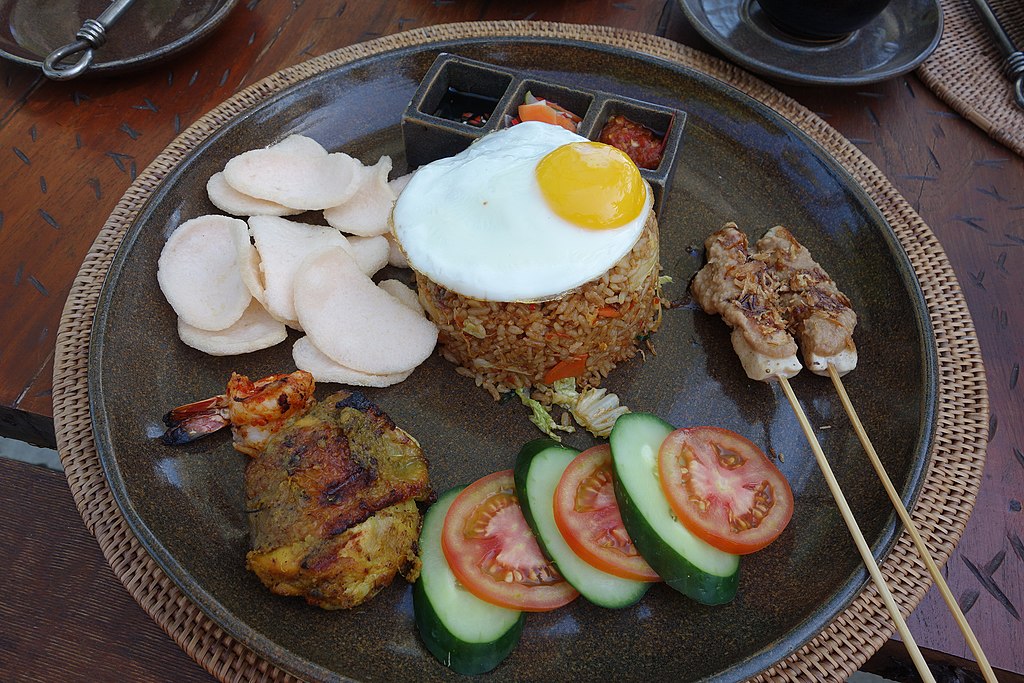


Great guide! Satay lilit is my absolute favorite Balinese dish.
Thanks Hiroshi. Yes Satay lilit is truly special. Glad you enjoyed the guide.